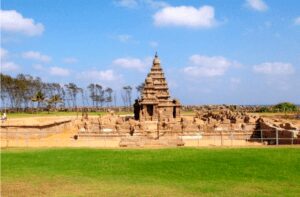The Weathering of the Monument of Shore Temple
The Monument of Shore Temple, located in Mahabalipuram (12◦36059″ N 80◦11055″ E), is among the first stone temples in Dravidian style in Southern India (Kumar & Singh, 2019). Further, it was attributed to the famous ruler of Narasimhavarman–II (722 CE), Pallava. The Shore Temple was built in the 7th and 8th centuries, half of it in the sea and half on land. Weathering damages such ancient buildings, especially if their material is stone and granite. Marine salts are the leading cause of weathering and deterioration of the Shore Temple (Kumar & Singh, 2019).
Salt Weathering of 7th Century CE Granite Monument of Shore Temple, Mahabalipuram.
Figure 1: The Shore Temple (Kumar & Singh, 2019).
Salt weathering refers to weathering caused by soluble and insoluble salts. Some salt weathering and damage mechanisms are crystallization and hydration pressure, differential thermal expansion, osmotic swelling of soils, and enhanced wet and dry cycles caused by deliquescent salts. The damage develops through crystallization pressure and the accumulation of salts (Kumar & Singh, 2019). Further, wind-mediated rain, high precipitation, fluctuation in relative humidity, and high temperature are some factors that deepen the penetration of salts into the porous ancient building. Salt damage on building materials varies depending on their concentration (Kumar & Singh, 2019). For instance, deliquescent salts may cause moisture on the surface of the building. Therefore, deterioration takes different forms, such as scaling, sanding, powdering, exfoliation, or flaking.
The main damage patterns observed at The Shore Temple Monument are impartiality of the surface, disaggregation, loss of consistency, and colour change (Kumar & Singh, 2019). Different parts of The Shore Temple illustrate different levels of damage. For example, the side facing the sea is damaged such that the sculptures are unrecognizable. This is due to the differences in the composition and texture of the granite stones used to build the temple (Kumar & Singh, 2019). Further, high precipitation and wind-mediated rain lead to salt penetration, resulting in hydronic expansion and stressing the granitic gneiss.
References
Kumar, S., & Singh, M. (2019). Salt Weathering of 7th Century CE Granite Monument of Shore Temple, Mahabalipuram – Scientific Investigation and Conservation Strategy. Heritage, 2(1), 230-253. https://doi.org/10.3390/heritage2010017
ORDER A PLAGIARISM-FREE PAPER HERE
We’ll write everything from scratch
Question
The Weathering of the Monument of Shore Temple
Select a national monument. How has it been affected by weathering? Be sure to specify the type of weathering it is exposed to.



